 Image search results - "bridge" Image search results - "bridge" |

Hiroshige's woodblock print of Nihonbashi from his "Fifty-Three Stations of the Tokaido Road" series.
|
|

Eisen's woodblock print of Nihonbashi from his Kisokaido series.
|
|

Chuo-dori avenue looking toward Nihonbashi Bridge.
|
|

Nihonbashi Bridge ahead, with the expressway over it.
|
|

The gateway to the Seta area is Karahashi-mae Station.
|
|
|

On July 29, 2007, this regatta was held for the second time. It targets mainly beginner rowers. Organized by the Seta Rowing Club which seeks to have more people enjoy water sports on Lake Biwa. Seta-Karahashi Bridge was the regatta's starting line. The Lake Biwa Rowing Song CD was awarded to all the 1st, 2nd, and 3rd place winners in all five categories.
|
|

Keihan train at Karahashi-mae Station.
|
|

The original Nihonbashi Bridge was built in 1603, out of wood.
|
|

Sixty rowing teams (300 people) rowed in five categories, including beginner and expert rowers, ranging in age from junior high to senior citizens.
|
|

Seta-no-Karahashi Bridge with the new paint job in 2012. 瀬田之唐橋
|
|

Nihonbashi Bridge and the ugly expressway above.
|
|

This is the boat dock where people got on and off the boats. The boats were provided by local rowing organizations. The regatta was organized by the Seta Rowing Club in Otsu.
|
|

The original Seta-no-Karahashi Bride was the site of historic battles. It has two bridges, one long and one short going over an island in the river.
|
|

Nihonbashi Bridge today is the 19th reconstructed Nihonbashi Bridge since 1603. 日本橋
|
|

A rowing team leaves the dock for Seta-Karahashi Bridge seen in the background.
|
|

On Bandai-bashi Bridge
|
|

In the foreground is Bandaibashi Bridge, spanning Shinano River.
|
|

The current bridge was rebuilt in 1979 and painted a beige color.
|
|

Bridge
|
|
|
|

Seta-Karahashi Bridge, the start line.
|
|

Bandai-bashi Bridge. The tall building is Toki Messe.
|
|
|
|
|
|

Up to four rowing teams raced down a 250-meter straight course.
|
|
|
|
|
|
|

Bridge ornaments
|
|
|
|

Seta-no-Karahashi Bridge in autumn. 瀬田之唐橋
|
|

Nihonbashi Bridge side view
|
|

All the boats are held stationary with a rope provided from the bridge.
|
|
|
|

Nihonbashi Bridge monument
|
|
|
|

The local neighborhood association wants this expressway to go underground.
|
|
|
|

The double-arched bridge was built in 1911, made of granite.
|
|
|
|

Replica of Nihonbashi Bridge at the Edo-Tokyo Museum in Ryogoku, Tokyo.
|
|

On the Nihonbashi Bridge replica at the Edo-Tokyo Museum in Ryogoku. It's not as arched as the one you see in ukiyoe prints.
|
|

About the replica of Nihonbashi Bridge at the Edo-Tokyo Museum in Ryogoku, Tokyo.
|
|

Seta-no-Karahashi Bridge with the new paint job in 2012.
|
|

Sky roof
|
|
|

Seta-no-Karahashi Bridge
|
|

Expressway above the bridge.
|
|

Most races were not close.
|
|

Nakahashi Bridge. During the Takayama Festival, ornate floats cross this bridge. 宮川に掛かる中橋
|
|

Seta-no-Karahashi Bridge over Seta River
|
|

One of the worse urban-planning decisions of the 1960s.
|
|
|

Nakahashi Bridge and pine tree
|
|
|

Nihonbashi River
|
|

The 250-meter course is very short, and each race ends within a minute or two.
|
|
|
|

Looking toward Nihonbashi on Chuo-dori
|
|

Finish line. In the background is the Kyoto University Rowing Club's boat house.
|
|

Nakahashi Bridge
|
|
|

Bridge lamps
|
|
|

Nakahashi Bridge
|
|

Gargoyles on bridge
|
|

The race had to be stopped for a few minutes each time this cruise boat passed by.
|
|
|
|

The Lake Biwa rowing Song CD was also sold.
|
|
|
|
|
|

Bridge to Nakashima island
|
|
|
|

The Lake Biwa rowing Song CD was also sold during the regatta which lasted from 9 am to 4 pm.
|
|

Train bridge
|
|
|

CDs
|
|
|

Train bridge
|
|

Nihonbashi as seen from Mitsukoshi Dept. Store.
|
|

Sketch of regatta course
|
|

Train bridge to Akihabara Station
|
|

Dragon boat
|
|

Dragon boat
|
|

Memorial square for the Zero Milestone for the Five Major Roads
|
|

Free rides on this dragon boat were also provided.
|
|
|

Japan's Zero Milestone for Roads 日本国道路元標
|
|

Dragon boat
|
|

Rowing on the dragon boat
|
|

Japan's Zero Milestone 日本国道路元標
|
|

Distances from the Zero Milestone to major cities such as Chiba, Mito, and Sapporo.
|
|

Dragon boat going to the Seta-Karahashi Bridge.
|
|

Distances from the Zero Milestone to major cities such as Yokohama, Kyoto, and Kagoshima.
|
|
|
|

A taiko drummer sits at the front of the dragon boat.
|
|
|

We rowed according to the taiko drum beat.
|
|

Crossing Kiyosu-bashi Bridge over Sumida River.
|
|
|
|

Crossing Kiyosu-bashi Bridge
|
|
|

Crossing Kiyosu-bashi Bridge
|
|
|
|

Raising the mikoshi on Kiyosu-bashi Bridge
|
|
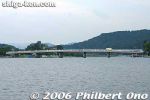
Seta Karahashi Bridge
|
|
|

Toyama Castle
|
|

Crossing Kiyosu-bashi Bridge. They chant "wasshoi wasshoi!" as they carry the mikoshi. 清洲橋
|
|

Crossing Kiyosu-bashi Bridge
|
|
|
|
|
|

With raised arms, this is one way to carry the mikoshi.
|
|

Seto Ohashi Bridge under construction in 1986.
|
|

One of two floating bridges supported by floating barrels. ドラム缶橋
|
|
|

Tsutenkyo Bridge 通天橋
|
|

This is near Ogochi Shrine.
|
|
|
|

建設中の瀬戸大橋
|
|

ドラム缶橋
|
|
|
|
|
|

ドラム缶橋
|
|
|

Tsutenkyo Bridge 通天橋
|
|

The bridge sways as you walk on it.
|
|

Kiyosu-bashi Bridge over the Sumida River, Important Cultural Property 清洲橋 国の重要文化財
|
|

Kurashiki end
|
|

View from Tsutenkyo Bridge 通天橋
|
|

The bridge can be disconnected and removed if necessary.
|
|

Crossing over Eitai-bashi Bridge. 永代橋
|
|

The double decker still not installed.
|
|

Floating drum ドラム缶橋
|
|

Tekomai geisha cross Eitai-bashi Bridge to enter Koto Ward along Eitai-dori.
|
|

Seto Ohashi Bridge under construction in 1986, Kurashiki.
|
|

Walking on the bridge
|
|

手古舞
|
|

Seto Ohashi Bridge under construction in 1986, Kurashiki. 瀬戸大橋
|
|

Koishikawa Korakuen Garden has a circular design around a pond and low hill. 回遊式庭園
|
|

Tekomai geisha at Eitai-bashi
|
|
|
|

Tekomai geisha at Eitaibashi
|
|

Shimotsui Seto Bridge to Hitsuishijima island
|
|

Tekomai geisha
|
|

Start of the double decker from Kurashiki.
|
|

They sing and chant while walking slowly.
|
|

Start of the double decker bridge.
|
|
|
|
|
|

Boat cruise for seeing the bridge.
|
|
|

Passed under the bridge.
|
|
|
|

Shimotsui Station
|
|
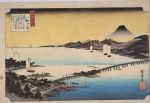
Hiroshige's woodblock print of Evening Glow at Seta from his "Omi Hakkei" (Eight Views of Omi) series.
|
|

Hiroshige's woodblock print of Evening Glow at Seta from his "Omi Hakkei" (Eight Views of Omi) series.
|
|

Foggy Seto Ohashi Bridge at Sakaide
|
|

Seta no Karahashi Bridge (stone sign) and Seta River. This was before the bridge got a new paint job in 2012. 瀬田の唐橋
|
|

Foggy Seto Ohashi Bridge at Sakaide
|
|
|

Gallery Karahashi is a fine-art rental gallery near Seta Karahashi Bridge ギャラリー唐橋
|
|

Foggy Seto Ohashi Bridge at Sakaide
|
|

Entrance to Seta Karahashi Bridge, west end. MAP
|
|

Miss Seto Ohashi for the Seto Ohashi Expo in 1988.
|
|

Crossing Seta Karahashi Bridge
|
|

Seto Ohashi Expo in 1988
|
|

Sinking yakata-bune boat
|
|

JR Shikoku Pavilion, Seto Ohashi Expo in 1988
|
|
|

Shikoku Pavilion, Seto Ohashi Expo in 1988
|
|

Seta Karahashi Bridge before the new paint job.
|
|

The tekomai geisha arrives at Tomioka Hachimangu Shrine.
|
|

Ferris wheel, Seto Ohashi Expo in 1988
|
|

Engetsukyo Bridge (Full Moon Bridge) 円月橋
|
|

Seta River seen from Seta Karahashi Bridge
|
|

The tekomai geisha enter the shrine.
|
|
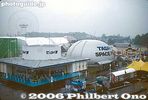
Seto Ohashi Expo in 1988
|
|

Stone bridge steps 円月橋
|
|
|
|
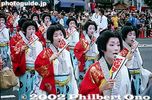
The tekomai geisha enter the shrine.
|
|

Old JR Sakaide Station. Notice the Seto Ohashi Bridge motif.
|
|

Engetsukyo Bridge (Full Moon Bridge) so named because it creates full moon with its reflection in the water. 円月橋
|
|

Seta Karahashi Bridge
|
|
|

Seta Karahashi Bridge, east end
|
|

The tekomai geisha enter Tomioka Hachimangu Shrine.
|
|

Naitei Inner Garden, formerly a private garden for a guesthouse built by the Mito Clan. The garden just does not match the huge Tokyo Dome in the background... 内庭
|
|

Seta no Karahashi Bridge, one of the Eight Views of Omi ( Omi Hakkei )
|
|

"Karahashi Bridge at Seta" before the new paint job in 2012.
|
|

Seta Karahashi Bridge crossing Seta River is a historically famous bridge.
|
|

Tossing a mikoshi.
|
|

Seta Karahashi Bridge from east end
|
|

Legend of Seta Karahashi Bridge with Fujiwara Hidesato who killed the giant centipede on Mt. Mikami.
|
|
|

Legend of Seta Karahashi Bridge about Fujiwara Hidesato who killed the giant centipede on Mt. Mikami.
|
|
|

Nezu Shrine bridge (built in 2006 神橋) and gate, Important Cultural Property 楼門(国指定重文)
|
|

Karahashi-mae Station on the Keihan Ishiyama Sakamoto Line is the closest station to Seta-no-Karahashi Bridge.
|
|

Ponte di Rialto bridge and gondola
|
|
|

Otemon Bridge
|
|

Going under Otemon Bridge. Wooden boards protect the bridge posts from the boat.
|
|

The boat is powered by very silent, battery-powered outboard motors.
|
|

Otemon Bridge
|
|

The next Otemon Bridge
|
|
|
|
|

Ready to pass under Otemon Bridge again.
|
|
|

View from Aioi Bridge.
|
|
|
|
|

In Japanese, the Imperial Palace is called "Kokyo" (皇居). This term begun to be used from 1948. Until then, it was called "Kyujo" (meaning palace castle 宮城)from the time Emperor Meiji took up residence.
|
|

Nijubashi Bridge, the symbol of the Imperial Palace and Tokyo. One of Japan's most famous bridges. There is another bridge behind this one. 二重橋
|
|
|
|
|
|

Rear of Nijubashi Bridge.
|
|
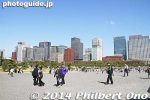
View of Marunouchi office buildings from Imperial Palace.
|
|

View from Nijubashi Bridge. The public can cross the bridge on the Emperor's Birthday (Dec. 23) and Jan. 2 for New Year's.
|
|

Crossing Nijubashi Bridge to enter the Seimon Gate. 正門
|
|

Weeping cherry blossoms near Otemon gate.
|
|
|
|
|
|
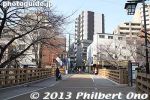
Itabashi Bridge goes over the Shakujii River. Itabashi-shuku (and Itabashi-ku Ward) got its name from this bridge. The first Itabashi Bridge was built during the Heian Period.
|
|

Itabashi means wooden plank bridge. The Itabashi Bridge during the Edo Period was a wooden arch bridge 16.4 meters long and 5.5 meters wide. In 1932, it was rebuilt with concrete. This current bridge was built in 1972.
|
|
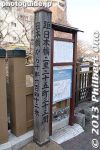
Sign post next to Itabashi Bridge indicating the distance to Nihonbashi.
|
|
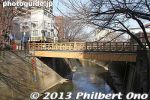
Itabashi Bridge over the Shakujii River.
|
|

Itabashi Bridge over the Shakujii River.
|
|

About the Itabashi Bridge.
|
|

Itabashi Bridge is one of Itabashi Ward's Ten Famous Sights.
|
|

Shakujii River as seen from Itabashi Bridge.
|
|

Shakujii River as seen from Itabashi Bridge. The bridge serves as the boundary between Naka-shuku and Kami-shuku.
|
|

Kami-shuku at Itabashi-shuku, Tokyo. More condos and fewer people walking around.
|
|
|

Biwako Ohashi Bridge is 1.35 km long connecting Moriyama and Katata across the neck of Lake Biwa.Biwako Ohashi Bridge also has a "melody road" with grooves on a 600m stretch of the bridge. When you drive over it, you can hear the melody for Biwako Shuko no Uta (Lake Biwa Rowing Song).
|
|

Biwako Ohashi Bridge also has a "melody road" with grooves on a 600m stretch of the bridge. When you drive over it, you can hear the melody for Biwako Shuko no Uta (Lake Biwa Rowing Song).
|
|
|
|